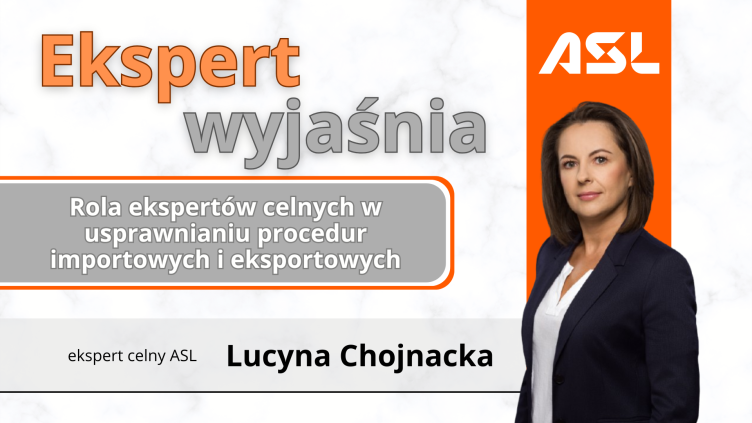Questions were answered by Lucyna Chojnacka, ASL customs expert with over 25 years of experience in customs law
Spis treści
ToggleWhat are the key responsibilities of a customs agent in the import and export process?
At the outset, it should be noted that a customs agent is very often confused with a customs officer. A customs officer is a customs and revenue officer, a civil servant working for the National Revenue Administration. A customs agent, on the other hand, represents entrepreneurs before the authorities of the customs and revenue office in matters relating to the circulation of goods and their marketing.
The list of duties of a customs agent is long. Among his/her main tasks we can include:
- completing and verifying the necessary commercial documents required for customs clearance
- advice on commodity classification
- calculation of customs duties, taxes and other charges advice on goods classification
- preparation and submission of import and export customs declarations
- representing clients before customs authorities during controls
What documents and formalities are necessary for customs clearance?
During international trade, it is important to prepare a number of key documents required for customs clearance. Presenting the correct set of documents enables faster customs clearance. The most important documents are:What documents and formalities are necessary for customs clearance?
- authority to carry out customs clearance
- commercial invoice – a document confirming a commercial transaction
- proforma invoice – a document stating the value of goods for customs purposes used in the case of non-commercial shipments, samples
- specification / packing list
- waybill depending on the mode of transport: air, sea, road, rail
- an invoice including transport costs – if based on INCOTERMS conditions
- permits/permits if required for the circulation of restricted or prohibited goods, e.g. food, pharmaceuticals, weapons, plants, etc.
- certificate of origin, CE declarations of conformity, certificates of analysis, health certificates, pallet fumigation certificate, SDS data sheet – if the imported goods require it
How can a customs expert help minimise costs and risks during customs clearance?
How can a customs expert help minimise costs and risks during customs clearance?
- advise on optimising the customs clearance process – thus avoiding delays and associated costs
- choose the right customs procedure – speeding up processes, reducing costs and even generating savings
- thoroughly prepares all required documents, verifies their correctness in accordance with the applicable regulations – thus minimising the risk of error and withholding of goods by the customs authority, which entails additional costs
- oraise legally for import and export sanctions and restrictions (dual-use and sanction goods verifications) – resulting in smooth customs clearance and avoiding additional costs for storing goods in temporary storage
- advise on the correct determination of customs value, anti-dumping duties, embargoes and the correct classification of goods – thus minimising the risk of errors and related penalties
- advise on customs preferences – which will help to reduce or completely eliminate customs duties on certain goods
What are the most common problems in import and export procedures?
In import and export procedures, we can encounter all sorts of problems that can lead to delays, additional costs and even financial penalties. Some of these are:
- Incomplete or erroneous documentation:
- Niekompletna lub błędna dokumentacja:
- no transport documents
- incorrect data on the value of the goods or the quantity
- discrepancies between different documents (e.g. invoice and packing list or waybill)
- no translation of what is being imported
- Incorrect merchandise classification – the use of an incorrect tariff code can result in overpayment of customs duties, penalties for underpayment and control by customs and revenue authorities.
- Mislabelling of goods, which can result in goods being detained by customs and not being released. Depending on the problem, there are several solutions to implement a corrective procedure.
- Delay in the delivery of documents or goods resulting in additional costs and problems with customs clearance.
- Incomplete delivery – discrepancy in quantity or type of goods between the actual condition and the documentation.
What are the key differences in customs procedures in different countries?
Familiarising oneself with the variety of regulations and customs procedures between different countries allows for efficient planning of trade activities and optimisation of the trader’s costs. This diversity of customs procedures concerns several aspects:
- customs rates – within the European Union the same customs rates apply while other countries have their own customs rate systems
- Customs procedures – each country has its own specific procedures, which vary according to the type of goods, their value or country of origin. Different rules apply for customs declarations, documentation and deadlines for the submission of documents. For example, the EU applies a common customs policy for all member states.
- Customs procedures – each country has its own specific procedures, which vary according to the type of goods, their value or country of origin. Different rules apply for customs declarations, documentation and deadlines for the submission of documents. For example, the EU applies a common customs policy for all member states.
- Phytosanitary, sanitary controls – some countries such as China and Australia apply strict sanitary and phytosanitary controls to prevent the introduction of pests and diseases
- Internal market protection policies – some countries apply higher tariffs on imported products to protect their own economies and local producers. An example is the policy in the US relating to certain steel or textile products
- restrictions and import bans – various countries introduce them for safety, public health or environmental reasons
- Customs controls – can vary from country to country. Some countries may have more detailed controls, while others may use simplified procedures.
How does customs clearance affect the fluidity of the supply chain?
In the system of logistics processes, customs clearance is a key element necessary for the smooth flow of goods across the border. The main aspects are:
- delays in deliveries that are caused by customs clearance. Customs procedures lengthen the delivery time of goods, which is why it is important to make use of professional customs support, which will have a significant impact on the timeliness of deliveries
- .customs documentation management – proper preparation and management of documents is key to ensuring the smoothness of customs processes. Every irregularity in documentation requires time to be clarified and corrected, which slows down the entire customs clearance process.
- customs control – in order to ensure the compliance of the customs declaration with customs legislation, the customs authority verifies the correctness and completeness of the information given in the customs declaration. It is also possible to control the goods with a so-called customs revision. This control extends the time for the completion of customs clearance. Using a professional customs agency with AEO status, among other things, reduces the number of customs controls, speeds up their execution and consignments selected for examination by customs authorities are treated as a priority.
- Liquidity – its loss is associated with the inability to pay current obligations and disruption of the continuity of supply. Selection of an appropriate customs procedure, e.g. fiscal, deferred VAT, 4200 procedure – allow not to pay VAT or postpone its payment.
Working with an experienced customs agency with AEO status that offers comprehensive customs handling, warehousing, transshipment, logistics and international transportation can significantly help optimize customs and tax costs, minimize the number of middlemen which will streamline the entire customs clearance process and make it easier to maintain liquidity in the supply chain.

 Contact
Contact 
